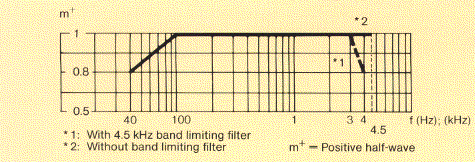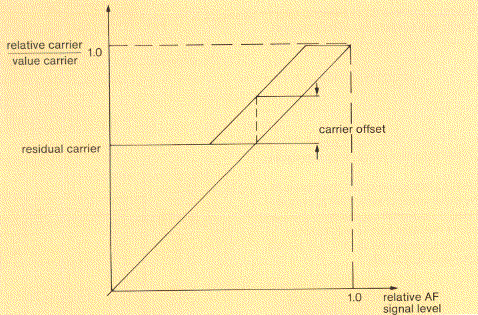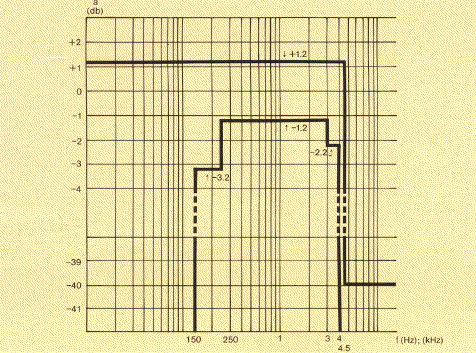(some frequencies outside the broadcast bands are available on request)
from 3.2 MHz available on request
Tuning time 30 seconds max. for AM, AM/reduced RF output power and DAM operation
Tuning time 60 seconds max. for SSB
AM/reduced RF output (on request)
DAM (on request)
SSB (on request)
- Input impedance
- Standing-wave ratio
- Driving power required
RF output
- Terminating impedance and
max. standing-wave ratio
- Rigid coaxial transmission line
Z = 50 ohms
VSWR equal or less than 2:1 at rated power
20 mW with permissible tolerance of ±3 dB
Z = 50 ohms, VSWR equal or less than 2:1 at rated power
(2 lt; vswr lt; 3):1 with automatic reduction of carrier power
45/103 (IEC 50-105)
- AF frequency range
- AF input impedance
- AF input level
- Method of modulation
40 Hz to 4500 Hz or
40 Hz to 7500 Hz (on request)
other ranges on request
600 ohms or more than 2000 ohms balanced and ungrounded
-4 dBm to +10 dBm
for m = 1 and fAF = 1000 Hz, adjustable in 0.5 dB ubcrenebts
Special AF processing on request
Anode voltage modulation of final stage of RF amplifier by PDM amplifier (PANTEL)
Co-modulation of screen grid of RF final stage tube via AF choke
One hour within a 6 hour period or 10 minutes within a 60 minute period

The frequency response measured at any input voltage within the previously stated modulation capability of the transmitters deviates from the frequency response measured at m = 0.5 by not more than ±0.5 dB

Distortion frequencies above AF bandwidth/2 are measured as out-of-band emissions acc. to CCIR 328-5 (AM operating mode)
More than 65 dB weighted acc. to DIN/IEC 244
Residual carrier reduction and carrier offset are adjustable
Recommended residual carrier: 0.6
Recommended carrier offset: approx. 0.2

Peak power
Transmitted sideband
Carrier reduction
Tolerance of carrier power
RF frequency change
Power limitation
RF power reduction
300 kW PEP
Upper sideband
(sideband change manual on drive unit or remote on control console)
-6 dB, -12 dB
(on request 2 additional carrier reduction values can be selected)
-10% to +15%
Full automatic tuning in the broadcast bands within 60 seconds
CW RF power is limited to 125 kW (rms) by automatic
power control device
Manually adjustable to -3 dB

Please state mains data when ordering
60 Hz version available on request
typical ratings at m = 0.35
up to 21.8 MHz
21.8-26.1 MHz
65%
62%
Depending on operating frequency and spread between components, e.g. tubes, variations up to ±5% may occur
Ratio of phase currents at rated load
Less than 1.1
 RF Section
RF Section